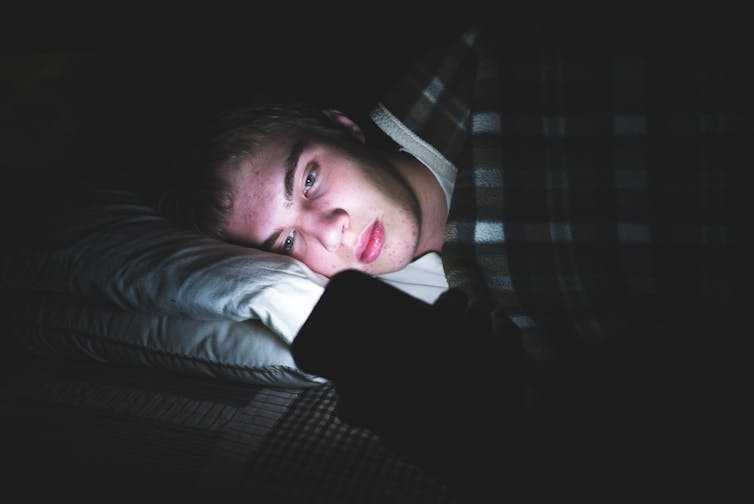How to know if your online shopping habit is a problem — and what to do if it is
- Written by Melissa Norberg, Associate Professor in Psychology, Macquarie University

As COVID-19 quarantines and lockdowns drive up psychological distress, many people have increased their screen time, including online shopping, to cope.
Like alcohol use — or overeating, watching TV or surfing the internet — online shopping doesn’t pose a problem when used as an occasional treat.
For some people, however, these behaviours can turn into habits that are hard to break.
Here’s how to know when online shopping becomes a problem and what to do if it does.
Read more: When possessions are poor substitutes for people: hoarding disorder and loneliness
How to know if it’s a problem
A behaviour becomes an addiction when at least three criteria are met:
- the behaviour is clearly excessive given its context
- it causes significant distress or impairment for the person or important people in their lives
- it persists despite not resulting in reward.
Shopping online for your weekly groceries would not usually be considered a behavioural addiction. Neither would making COVID-19 related online purchases of exercise equipment, office supplies, or masks.
However, online shopping might be considered addiction-like if you find yourself doing the following:
- spending a great deal of time shopping
- buying a lot more than you need
- finding it hard to stop shopping even though you rarely seem to enjoy the stuff you buy.
Relationship issues and financial hardship are other key clues your online shopping has become a problem.
Some people may experience online shopping problems without even spending a lot of money; just spending excessive amounts of time browsing products may be enough to warrant reflection and possibly intervention.
 Relationship issues and financial hardship are key clues your online shopping has become a problem. Shutterstock
Relationship issues and financial hardship are key clues your online shopping has become a problem. Shutterstock
Read more: Psychology can explain why coronavirus drives us to panic buy. It also provides tips on how to stop
What does the research say about online shopping and addiction?
For many people, shopping can be a social or leisurely activity. It can feel good, and desires to feel good (and not bad) can get wrapped up with the desire to buy and own material possessions.
In fact, research from my (Melissa Norberg) lab suggests compulsive shopping can be associated with a feeling of being unable to deal with distress.
Problematic shopping also may occur when people attempt to compensate for an unmet psychological need, such as a need to feel competent, in control, or connected to others.
People sometimes turn to comfort products when they feel unsupported by significant others. They may buy compulsively when they feel ambivalent or confused about their sense of self.
So it’s not surprising that during the pandemic, many people report turning to online shopping to cope with significant changes to their social, work and family lives.
Australia experienced a surge in online shopping in March and April and online spending now remains well above what it was a year ago.
What to do if you want to cut back
If online shopping or browsing is interfering with your life, there are several strategies you can try.
The first is to determine what triggers your online shopping. Are you trying to feel better about yourself or relieve negative emotions such as boredom, stress or anxiety? Are you experiencing poor sleep or unhealthy eating? (If so, upsetting events might be more difficult to manage).
Is the online shopping occurring mostly at a certain time of day or in certain circumstances (after a glass or two of wine, after scrolling social media or when you’re lying in bed at the end of a long day, for example?)
 Try to determine what triggers your online shopping. Shutterstock
Try to determine what triggers your online shopping. Shutterstock
Next, try to figure out if there are other, more effective ways you can respond to whatever is triggering your excessive shopping.
If you tend to react impulsively to situations, practise identifying your urge to respond and then sitting with that discomfort so that you can choose a less impulsive and more productive or fulfilling response. Being able to tolerate negative emotions and respond flexibly to stressful situations is associated with healthier outcomes.
Chatting on the phone (or by text) with a friend, doing a peaceful activity (taking a bath, reading a book), exercising, or practising a hobby can help you to feel supported, relaxed, and talented. These activities also can lessen anxiety and depression.
Once you determine what you can do instead of shopping, develop a daily schedule. Having a schedule will help you feel more in control of your life and reduce the time available to shop online.
Try to set goals and monitor your shopping behaviour.
You can also try to:
- make shopping lists (and stick to them) when buying groceries and other essential items
- set a timer to limit how long you browse
- set constraints on how much you spend
- if possible, use debit cards instead of credit cards so you can only spend money you have
- steer clear of “buy now, pay later” services such as Afterpay
- if you have multiple credit cards, consider closing them to limit your ability to spend money you don’t have.
 Try to set goals and monitor your shopping behaviour. Shutterstock
Try to set goals and monitor your shopping behaviour. Shutterstock
And don’t forget to reward yourself (with something other than shopping) when you meet your goals.
Research has found these strategies can help people reduce their compulsive shopping.
If you have trouble reducing your shopping behaviour on your own, seek help from a professional. If you visit your GP, they can refer you to a specialist and provide you with a mental health care plan, which entitles you to Medicare rebates for up to 10 individual and 10 group appointments with some mental health services in a year.
If this article has raised issues for you, or if you’re concerned about someone you know, call Lifeline on 13 11 14.
Authors: Melissa Norberg, Associate Professor in Psychology, Macquarie University





